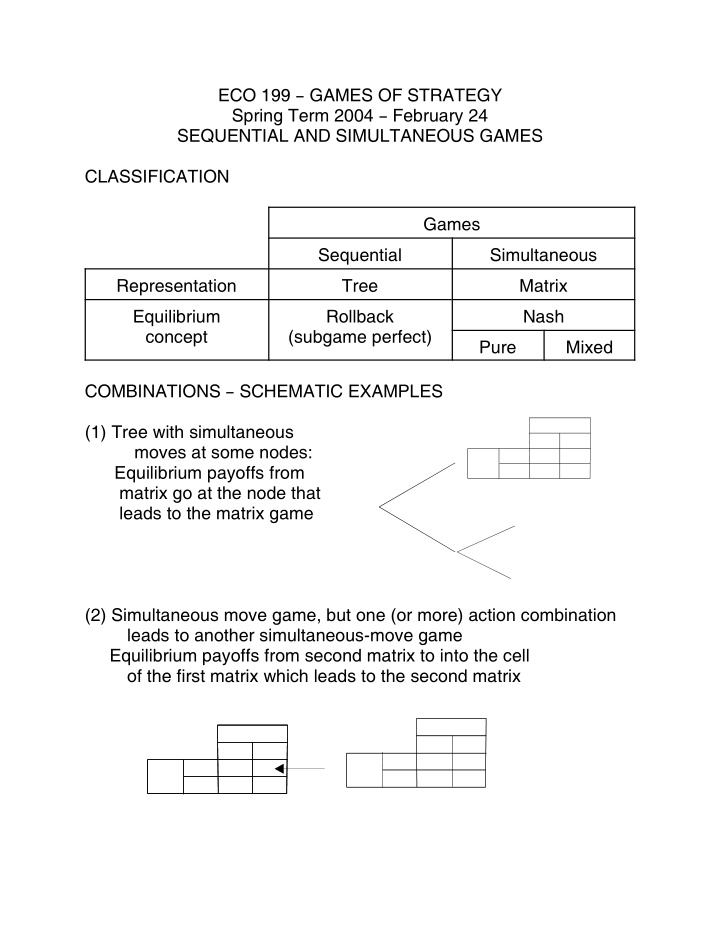



ECO 199 B GAMES OF STRATEGY Spring Term 2004 B February 24 SEQUENTIAL AND SIMULTANEOUS GAMES CLASSIFICATION Games Sequential Simultaneous Representation Tree Matrix Equilibrium Rollback Nash concept (subgame perfect) Pure Mixed COMBINATIONS B SCHEMATIC EXAMPLES (1) Tree with simultaneous moves at some nodes: Equilibrium payoffs from matrix go at the node that leads to the matrix game (2) Simultaneous move game, but one (or more) action combination leads to another simultaneous-move game Equilibrium payoffs from second matrix to into the cell of the first matrix which leads to the second matrix
RULE CHANGES Cold war example Original simultaneous-move game USA Restrained Aggressive Restrained 3 , 4 1 , 3 USSR Aggressive 4 , 1 2 , 2 Sequential moves B US moves first USSR responds A irrespective of whether US chooses R or A B A is USSR’s dominant strategy.
Sequential move B USSR moves first In view of the different US responses, USSR chooses R, even though A is its dominant strategy. Concept of dominance is relevant for simultaneous moves, or for later mover in sequential-move game The concept of dominance may not be relevant for an earlier mover in a sequential-move game. Dominance says that one strategy is better for you than another for each given strategy of the other. But for an earlier mover, the later movers’ strategies are not given; the choice of the early move by one player can change these responses of the others. In fact the very purpose of the early move may be to bring about such changes; that is what a leadership or first-mover advantage is all about. This will be the essential idea of the "strategic move" called Commitment that we will study later.
ANALYZING SIMULTANEOUS GAME IN TREE FORM Prisoners’ dilemma example An information set encompasses the nodes between which the player scheduled to move there is unable to distinguish Necessary to have the same player(s) acting, and the same number and labels of actions available, at all points of an info. set The same action must be chosen at all nodes in an info. set Thus new definition of strategy B a complete plan of action, specifying the choice to be made at every information set (replacing the previous at every node ) where it is that player’s turn to move, whether or not that information set is going to be reached on the actual path of play Reminder B For a game to be simultaneous-move, the physical timing of moves is not important. It is important that the later mover does not observe the earlier mover’s choice. Conversely, for a game to have sequential moves, it is important that earlier actions are (1) observable, (2) irreversible.
ANALYZING A SEQUENTIAL-MOVE GAME IN MATRIX (OR "STRATEGIC") FORM Regard the complete plans of action as strategies, and show them and the resulting payoffs in a matrix. In the sequential version of the cold war example, with the USSR moving first, the US has four strategies: 1. R if R, A if A (Match) 2. R if A, A if R (Reverse) 3. R if R, R if A ( R always), 4. A if R, A if A ( A always) USA Match Reverse R always A always R 3 , 4 1 , 3 3 , 4 1 , 3 USSR A 2 , 2 4 , 1 4 , 1 2 , 2 This has two Nash equilibria shown with gray fill in the cells. Bottom-right is the Nash equilibrium of the simultaneous-move game. It is a Nash equilibrium of the sequential move game written in its matrix or "strategic" form, because given that if US plays "A always" (or the USSR believes that it doe), it is best for the USSR to play A, and given that the USSR plays A (or the US believes it does), it is best (although tied with "Match") for the US to play "A always". So the beliefs and actions can be mutually reinforcing. But top-left is the rollback equilibrium of the sequential-move game. Here the US can observe what the USSR has done, so it need not rely on any previous belief about the USSR’s move. Then the USSR can correctly predict that the US will follow the "Match" strategy, and that makes it optimal for the USSR to choose R. Rollback is also "subgame perfect" B after any sequence of earlier moves, the continuation of the strategies to the remaining part of a full game remains an equilibrium of that part.
Recommend
More recommend